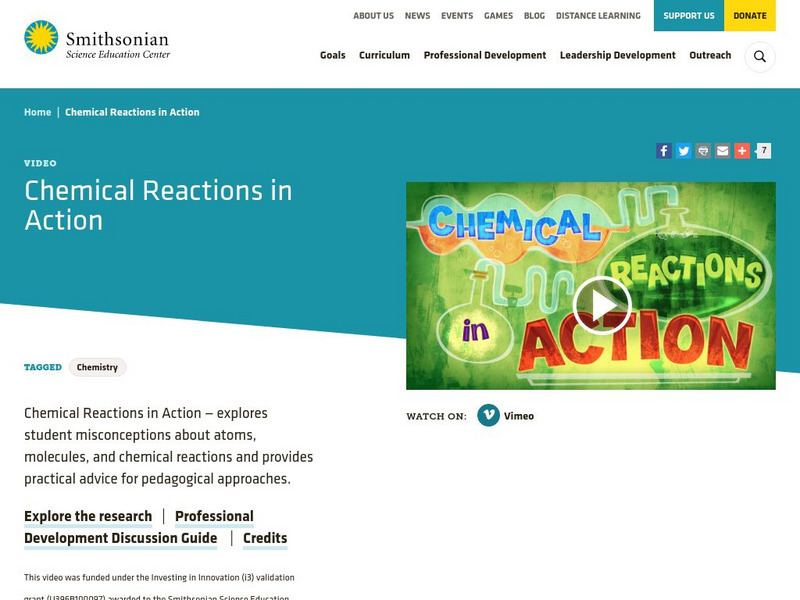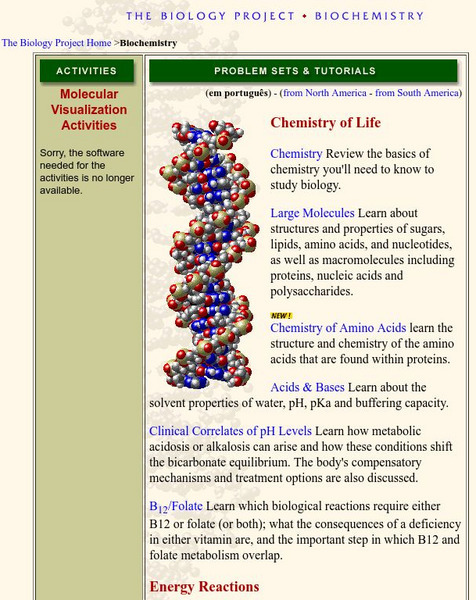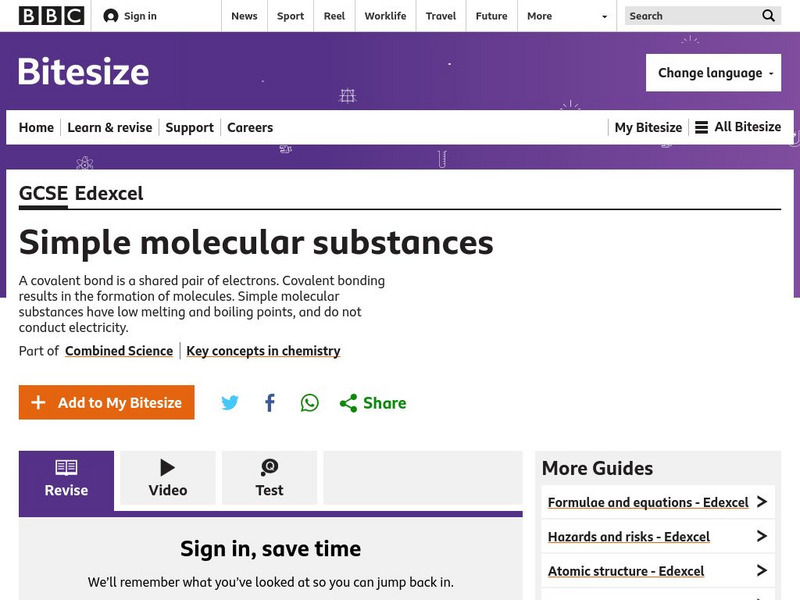Nobel Media AB
The Nobel Prize: The Nobel Prize in Chemistry 1934
At this website from The Nobel e-Museum, read about Harold Clayton Urey (1893-1981 CE), the chemist awarded with a Nobel Prize "for his discovery of heavy hydrogen." Download Urey's Nobel Lecture, "Some thermodynamic properties of...
Khan Academy
Khan Academy: The Mole and Avogadro's Number
An explanation the mole (named for molecule) and Avogadro's Number. One mole of a substance is equal to 6.022 times 10 to 23rd power units of that substance (such as atoms, molecules, or ions). The number 6.022 time 10 to 23rd power is...
Texas Instruments
Texas Instruments: Matter
This Study Card stack enables students to review the concepts of matter, the kinds and classes of mater including atoms, molecules, elements, compounds, pure substance, and mixtures.
Smithsonian Institution
Smithsonian Science Education Center: Chemical Reactions in Action
This video is a professional development resource that explores student misconceptions about atoms, molecules, and chemical reactions. It also gives some pedagogical approaches for approaching these subjects. [10:12]
Curated OER
Science Kids: Science Images: 3 D Carbon Monoxide Molecule
This is a computer generated 3D image of a carbon monoxide molecule. Carbon monoxide contains one carbon atom and one oxygen atom. It is an odorless gas that is highly toxic to humans.
Curated OER
Simon Fraser University: Molecules and the Properties of Bonded Atoms
Water molecule, complete with coordinates.
Curated OER
Simon Fraser University: Molecules and the Properties of Bonded Atoms
Drawing of sucrose molecule -- table sugar. Colors show negative electrical potential on its molecular surface.
Curated OER
Simon Fraser University: Molecules and the Properties of Bonded Atoms
Drawing of a caffeine molecule. Hydrogen = white; Carbon = blue; Oxygen = red
Curated OER
Simon Fraser University: Molecules and the Properties of Bonded Atoms
Atomic Force Microscopy (AFM) method used to get an image of the first molecule -- a pentacene structure -- in Switzerland, 2009.
Curated OER
Science Kids: Science Images: Ozone Molecule
This diagram shows a 3D computer generated image of the triatomic molecule known as ozone. Ozone is an allotrope that contains three oxygen atoms. The ozone layer found in the upper atmosphere helps protect the Earth against potentially...
Bill Nye
Bill Nye: Hole Y Water
Try this at-home science experiment to learn that a glass of water molecules contains a whole lot of space.
University of Arizona
University of Arizona: Biochemistry
Problem sets, tutorials, and activities related to biochemistry.
American Chemical Society
American Chemical Society: Hompage
ChemCenter, available from the American Chemical Society, provides chemistry news, reference sources and other public services.
Other
Institute of Physics: Practical Physics
Access hundreds of teacher-tested, practical physics lessons on this well-organized, illustrated site. Find just the right demonstration, attention-grabber, or lab for any physics teaching objective at your fingertips.
Georgia Department of Education
Ga Virtual Learning: Ap Chemistry: Welcome
An introduction to the College Board's AP Chemistry course, which is designed to be equivalent to a first year college chemistry course.
State University of New York
State University of New York: Determining Molecular Shapes
In this exercise students will select the electron-pair geometry for a molecule and drag it onto the central atom. Then they will place the terminal atoms in the appropriate positions on the molecule. Finally students will enter the...
Concord Consortium
Concord Consortium: Molecular Workbench: Collision Theory of Chemical Reactions
Watch an animation of atoms and molecules colliding that shows how these particles combine during chemical reactions. Change levels of energy to see how reactions are affected.
Sophia Learning
Sophia: Converting From Grams to Particles: Lesson 2
This lesson demonstrates how to convert from grams to particles (molecules, atoms, ion). It is 2 of 2 in the series titled "Converting from Grams to Particles."
Concord Consortium
Concord Consortium: What Makes Water Special?
Activity 4 investigates How does electron distribution impact our observations? Students have described how properties of molecules change depending on what atoms make up the molecule. In this activity students will use those ideas to...
Nobel Media AB
The Nobel Prize: Chirality Chemistry 2001
In 2001 the Nobel prize in chemistry was awarded for work with Chiral molecules. These molecules can be used to control the speed of chemical reactions. This brief game teaches the basic principles of chirality.
TED Talks
Ted: Ted Ed: What Is the Universe Made Of?
The atoms around you have existed for billions of years- and most originated in the flaming, gaseous core of a star. Dennis Wildfogel tells the captivating tale of these atoms' long journeys from the Big Bang to the molecules they form...
The Wonder of Science
The Wonder of Science: Ms Ps1 1: Atomic Composition Model
A collection of lesson plans for helping students understand atomic composition. Site uses work samples, phenomena, assessment templates, and videos to plan lessons to describe the atomic composition of simple molecules.
CK-12 Foundation
Ck 12: Life Science: 2.1 Elements and Compounds
Learn how basic elements form molecules to support life.
BBC
Bbc: Gcse Bitesize: Covalent Bonds
A covalent bond is formed between non metal atoms, which combine together by sharing electrons. Covalent compounds have no free electrons and no ions so they don't conduct electricity.
Other popular searches
- Gumdrop Atoms and Molecules
- Counting Atoms Molecules
- Making Atoms and Molecules
- Atoms & Molecules Ppt
- Matter Atoms Molecules
- Science, Atoms and Molecules
- Science Atoms and Molecules
- Atoms Molecules Elements
- Atoms & Molecules Pot
- Atoms and Molecules Lesson
- Atoms Molecules Units
- Atoms and Molecules Musical















